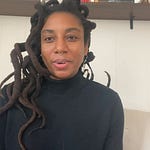Hi Everyone,
I’m very pleased to share the audiobook version of my essay:
You’re welcome to either listen to the audio on its own, or you can read along with the written essay, which contains source materials from Pauli Murray’s archives.
I decided to add a little twist by integrating music breaks from a few prominent black lesbian Songstresses of Pauli’s youth (1920s-40s), including Lucille Bogan, Ma Rainey, and Gladys Bentley.
This audio-essay highlights music with bold themes around the black lesbian experience, opening with Lucille Bogan’s “BD Women Blues”.
BD stands for “Bull-Dagger” or “Bull-Dyke”—an old-school term commonly used in the African-American community to describe a masculine black lesbian:
Coming a time, B.D. women ain't gon' need no men
Coming a time, B.D. womens ain't gon' to need no men
Oh, the way treat us is a lowdown and dirty sin
B.D. women, you sure can't understand
B.D. women, you sure can't understand
They got a head like a sweet angel and they walk just like a natural man
A longer interlude in the essay features Ma Rainey’s “Prove It On Me”:
They say I do it, ain't nobody caught me
Sure got to prove it on me;
Went out last night with a crowd of my friends,
They must've been women, 'cause I don't like no men.
It's true I wear a collar and a tie,
Makes the wind blow all the while
Don't you say I do it, ain't nobody caught me
You sure got to prove it on me.
Finally, Gladys Bentley closes out the essay with her rich, bluesy vocals. While researching music for this audiobook, I discovered that Gladys Bentley also underwent medical conversion therapy in an attempt cure her homosexuality. In the 1950s, Ebony Magazine featured an article with her claiming to be a success story.
The title of the article was “I’m a Woman Again”.
I would eventually like to write a separate piece about this, but for the purposes of this audio piece, I chose to include Gladys’s music because, although she doesn’t have any recorded music explicitly speaking about her relationships with women, her lived experience in struggling with her sexuality most closely mirrors Pauli’s.
I included voices and art from black lesbians of Pauli’s time alongside this essay, because Pauli was not alone in her experience. In both a symbolic and truthful way, this audiobook represents that.












